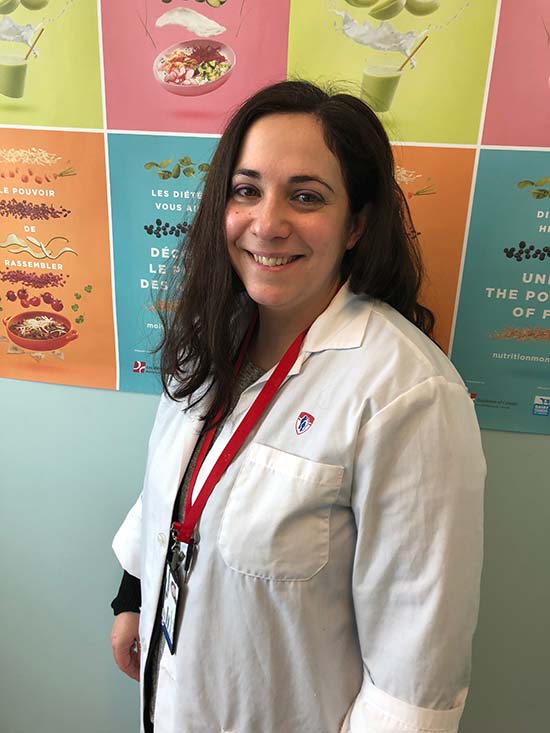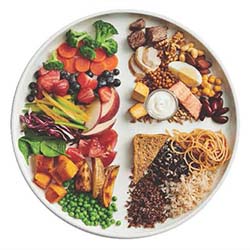Health through diet
Lidia Ojeda’s appointment at the Pain Clinic had just finished when we met on a Friday afternoon at the Montreal General Hospital of the McGill University Health Centre (MGH-MUHC). While we were looking for a quiet place to sit and talk, it was clear she knew her way around the hospital.
“I've been coming here for years,” Lidia said. “I had a kidney transplant four years ago and I was very happy but, unfortunately, I got the shingles in November 2017. As a result, I was hospitalized for a week and ended up with chronic pain and I lost 25 pounds. That is why I was referred to the Pain Clinic, and to the Nutrition Clinic, at the Glen.”

Lidia Ojeda
Thanks to the help she received at the Nutrition clinic of the Royal Victoria Hospital of the MUHC (RVH-MUHC), Lidia has regained 20 pounds and is on her way to adding on another five. The road traveled to get there was not an easy one as she struggled with weight gain up until December 2018.
“At first, I tried to gain back the weight by myself, but it wasn’t working. I had no appetite. I would eat, but not enough calories,” she said. “So my doctor, Dr. Marcelo Cantarovich, referred me to the nutrition service”.
At the Nutrition clinic, Lidia underwent a thorough needs assessment allowing a medical profile to be created and a personalized diet plan to be designed for her.
Lidia adopted a healthy, high calorie, high protein diet that showed limited success at first. At a follow-up appointment, she was asked to increase her portions and was prescribed a special drink to help her meet her goals. And it finally paid off.
“What I liked very much about at the Nutrition clinic, is that they listened to me and specifically made a plan for me”, she says. “And it was very successful.”
Custom recommendations
All patients who visit the MUHC Nutrition Clinics at the RVH-MUHC or MGH-MUHC are already being followed due to health concerns. Some are diabetic, others have heart conditions, some suffer from gastro-intestinal problems or some need support post cancer treatments. They all need advice tailored to their own situation so an evaluation addressing their specific needs is addressed from the first visit.
“We document their medical history, their results from the laboratory, their eating habits, their weight history, and medications used as some drugs can interact with certain foods or nutrients.” explains MUHC nutritionist Stephanie Shabat.
“This allows us to formulate a nutritional plan and develop recommendations. It’s important to establish a dialogue with our patients by considering their nutritional status, their knowledge of nutrition and their lifestyle habits since they need information, advice and encouragement to reach their goals.”

Stephanie Shabat
One traditional means of teaching nutrition –the one used in the new Canadian Food Guide– is called the pate method which shows what proportions certain foods should take on our plate.
“We make use of Canada’s Food Guide with our patients and the newest edition is effective in presenting pictures of real foods so I no longer have to draw a plate as an illustration!” says Stephanie.
The guide, for example, suggests higher consumption of plant-based proteins without suggesting the elimination of meat or dairy, which have been regrouped into the protein category. The guide also recalls that everyone should eat more fruit and vegetables.
“If a patient is used to eating meat every day, I would suggest they try switching to a vegetarian meal once a week. That’s a good first step,” Stephanie says.
Patients who visit the clinic are generally motivated to change their eating habits because they know it can contribute to improving their health. Nevertheless, changing those eating habits remains an obstacle.
“We can’t change everything at once,” explains Stephanie, “we need to start by setting realistic objectives and recognize each success of the patient when they achieve it. For some patients, replacing juice and sodas with water makes an enormous difference.”
Once the objectives are met, the next challenge is to help patients maintain their healthy habits and take up a “normal” diet.
“The food guide is a useful tool but it’s up to us to respond to the nuances and specific demands of each patient,” Stephanie says. “That’s what we are here for.”
“I still have five pounds to gain”, says Lidia.
“Then, I’ll have to maintain my weight. And the thing is, I’m hungry now!” she adds, laughing.

The new edition of Canada’s Food Guide: A useful tool for eating healthy
The release of the new Canadian Food Guide in January 2019 received a lot of attention. It revolves around two important ideas: opting for healthy eating options and adopting healthy dietary habits like being mindful of eating habits and cooking more often. Instead of talking about portions, it discusses proportions, and recommends:
- Eat fruits and vegetables in abundance
- Consume a variety of protein foods, including those with a vegetable base (nuts, grains, vegetables)
- Make water the beverage of choice
- Opt for whole grain foods
- Limit the intake of processed foods
